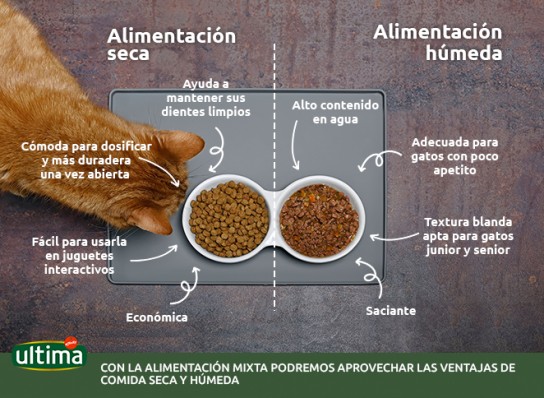Our cats walk, sleep peacefully, play on the carpet or do any other cuteness that gets thousands of likes on Instagram. Raise your hand whoever hasn't stopped for a while to look at cat reels and time has run out. They are so enigmatic, elegant, special, interested, sensitives and funny... and they have been living with us for approximately 10 thousand years.
In Spain, almost 4 million domestic cats were registered in 2020, according to the European pet food industry, a figure somewhat lower than that the one of dogs, but higher than the previous year. And yet, many times we still have doubts about how to feed them so they don't get too fat or get sick, and also to make them happy. Is it better to give them only dry pet food? Only wet pet food? Both? It is a frequent question among cat parents. The answer is easy: both. This is what is called 'mixed feeding', a method that consists of combining dry and wet pet food in your cat's daily diet to obtain the maximum benefits of both formats for the well-being of your cat.
{{editor}}
Both dry and wet pet food are suitable for your cat if you choose them correctly and adapt them to their daily needs
Dry food has multiple benefits, such as helping to keep teeth cleaner; convenience when dosing and keeping it; the fact that it keeps better if we leave it in the bowl all day (something useful for the cat who eats just a little during the whole day, as it would in nature), and that´s somewhat cheaper than wet food.
Wet pet food is attractive to felines, which are generally very demanding with food, and it is emerging as a great option to stimulate their appetite. It´s fragrant, its texture is juicy, its flavors are delicious and varied... Cats prefer it since kittens choose food for its smell and texture and not so much for its taste.

The great benefits of wet pet food are two. On one hand, it provides a lot of water, essential for a species that -due to its desert origin- tends to drink little and concentrate its urine for a long time. 'Cats are prone to urinary tract problems and wet pet food can help them prevent this type of pathology,' explains Beatriz Martínez, a veterinary expert in nutrition at Hospital Veteralia Movet.
On the other hand, it is a great supplement that provides essential nutrients to our cat, especially if he is a kitty with little appetite (a classic), a senior (the soft texture will help him chew more easily) or a cat with some type of illness. And it is that the variety is the taste: by having a wide range of alternatives and textures, it´s easier to find your preferences.
Truths and Myths of wet pet Food
Wet cat food is more unknown than dry. There are many myths surrounding this format of feeding for kittens, which usually comes rationed in individual bags or cans with pieces of meat or minced meat in sauce, creamy pâté, fish fillets, mousse, puree, jelly or broth.
For example, there is a tendency to think that wet food will make the pussycat fat, when the reality is that, due to its humidity, it is less caloric than dry food. The key to keeping your cat from gaining weight is, above all, to respect the portions and the calories that the cat needs. When choosing a wet diet for our cat, we must pay attention that it meets its nutritional needs and is adapted to its age and condition (whether it is sterilized or not, if it suffers from any disease...). It will be your veterinarian who can best detail what amount is recommended based on his age, energy and state of health.
'The ideal is to combine both diets, the dry one for better conservation and comfort and the wet one to continue stimulating its appetite with tasty textures, in addition to compensating for that possible lack of hydration, and also in special cases of disease or age of the feline' , states the veterinarian.
by La Vanguardia
You could be interested: Understanding Minimally Processed: What It Really Means for Your Pets Food



































